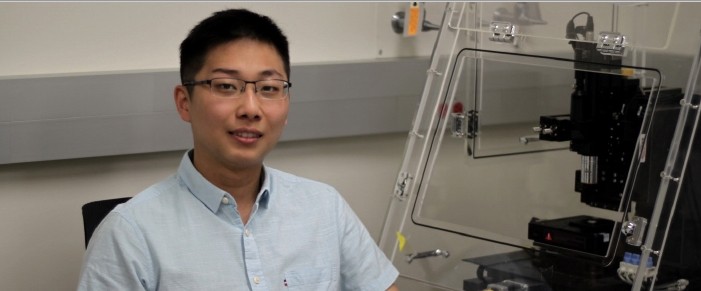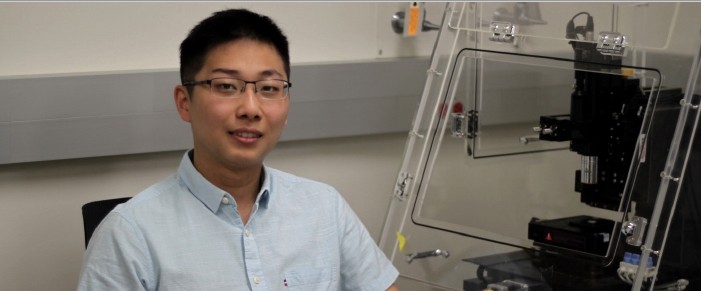Park AFM Scholarship Awards - Jingshan Du
- 04 Jun 2018
- Volume 13
- NanoScientific Magazine, Spring 2018

WEBSITE: HTTP://DUJINGSHAN.TK
“I USE THE PARK AFM TO GENERATE NANO REACTORS ON ELECTRON-TRANSPARENT SUBSTRATES. THE PRECISE CONTROL OF SCANNING PROBE POSITION IN THREE DIMENSIONS ALLOWED ME TO DEPOSIT NANOSCALE FEATURES OF FLUIDS, SUCH AS POLYMER SOLUTIONS, ONTO FILMS THAT ARE ONLY FEW NANOMETERS THICK.”
Jingshan Du is currently a graduate student in the Department of Materials Science and Engineering, Northwestern University. Jingshan Du received his B.S. in Engineering: Materials Science and Engineering from Chu Kochen Honors College, Zhejiang University in China, where he worked with Prof. Deren Yang and Prof. Hui Zhang on the colloidal synthesis of hybrid nanomaterials. Before joining Northwestern, he spent his senior year in Prof. David A. Weitz’s group at Harvard studying the radiation-induced transformation of nanoparticles using in situ TEM. His current research includes the structures and structural transformation of multicomponent nanoparticles. He was a recipient of a Ryan Fellowship from Northwestern, a Chu Kochen Scholarship from Zhejiang University, and a CSST Award from UCLA.
Please summarize the research you do and explain why it is significant?
Nanoparticles consisting of multiple elements and phases have shown great potentials in enabling multifunctionality and tuning the functionality of each component for various applications, ranging from plasmonics to catalysis.My research focuses on understanding how different elements and phases construct a nanoparticle, evolve in environments, and exhibit interesting properties. Correlative electron microscopy provides multidimensional information on the structures and structural evolution of the complex nanoparticles generated by scanning probe block copolymer lithography (SPBCL). These studies may not only shine light on fundamental chemical physics in nanoscale systems, but also help the design of high performance and multifunctional nanomaterials such as catalysts, sensors, and medicines.

Jingshan Du pictured above wit Park AFM at Northwestern University where he uses the unique nanolithography module in Park AFM
to rapidly generate nanoreactor arrays on an electron microscopy-compatible substrate.
How might your research be used?
From a basic science perspective, my study provides insights into how multiple elements, phases, and materials interact and evolve in nanoparticles in different environments. This allows us to look at complex multicomponent nanoparticles in a new way, as complex systems, and start to understand their behaviors that stem from fundamental chemical physics. We also invest significant efforts into studying their properties such as plasmonics and catalysis. These multicomponent nanoparticles, with the desired composition and structure, may be able to enable some exciting new applications such as cascade catalysis.
Why is the Park AFM important for your research?
My research focuses on interfacing nanopatterning techniques and electron microscopy into a platform for investigating complex nanoparticle systems. These systems, including multicomponent, multiphase nanoparticles, and their interfaces with fluids and gases, are generally difficult to prepare in a systematic and combinatorial way. I use the Park AFM to generate nano reactors on electrontransparent substrates. The precise control of scanning probe position in three dimensions allowed me to deposit nanoscale features of fluids, such as polymer solutions, onto films that are only few nanometers thick.
What features of Park AFM are the most beneficial and why?
The unique nanolithography module in environments. This allows us to look at complex multicomponent nanoparticles in a new way, as complex systems, and start to understand their behaviors that stem from fundamental chemical physics.We also invest significant efforts into studying their properties such as plasmonics and catalysis. These multicomponent nanoparticles, with the desired composition and structure, may be able to enable some exciting new applications such as cascade catalysis.
Why is the Park AFM important for your research?
My research focuses on interfacing nanopatterning techniques and electron microscopy into a platform for investigating complex nanoparticle systems. These systems, including multicomponent, multiphase nanoparticles, and their interfaces with fluids and gases, are generally difficult to prepare in a systematic and combinatorial way. I use the Park AFM to generate nano reactors on electron-transparent substrates. The precise control of scanning probe position in three dimensions allowed me to deposit nanoscale features of fluids, such as polymer solutions, onto films that are only few nanometers thick.
What features of Park AFM are the most beneficial and why?
The unique nanolithography module in Park AFM allows us to rapidly generate nanoreactor arrays on an electron microscopy-compatible substrate. Compared to other sample preparation methods that result in randomly located nanoparticles, the regular arrays generated on Park AFM enables us to index and trace back to each particle repeatedly. This makes correlative characterization, ex situ, and in situ studies using electron microscopy possible on the individual nanoparticle level.
